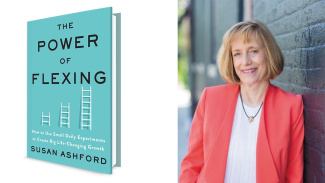Book By Michigan Ross Professor Explores the Power of ‘Flexing’ to Develop New Skills

Small behavioral experiments in daily life can lead to tremendous personal growth, according to a new book by Ross School of Business Professor Sue Ashford.
The Power of Flexing describes a system useful for anyone wanting to gain skills or overcome challenges. After setting a personal growth goal, you devise experiments to test out different strategies for making progress on the goal; then you seek feedback, and then reflect.
The system can make you a more effective leader or help you grow as a person in other ways, Ashford explained. It can also work as a template for organizations hoping to create contexts that foster the growth and development of their employees.
“My fondest hope is that the book will be useful for people, that they'll find inspiration to grow and help in doing so,” Ashford said.
She recently sat down to discuss the books and its approach to growth.
This is the first full-length book you have written. What about this topic inspired you?
Ashford: This is a framework that I've been teaching for a lot of years, particularly to people interested in developing leadership. People have always found it very useful, for that and also for how to grow more generally (e.g., as a parent or partner). It has always created a lot of positive reaction. So I decided to jump in and write about it.
How do you define the concept of “flexing”?
Ashford: Flexing captures a very different approach to developing leadership and developing yourself generally. It’s not predicated on your organization tapping you as having high potential and then putting you through growth experiences. Rather, it starts from the idea that you own your own growth and lays out a set of practices tied to learning from your experiences that you can use flexibly in your life to grow when and how you most want.
One of the core practices in this system is trying something new — trying a set of experiments with your behavior to see if you can improve things with one approach or another. That’s flexing. Because personal effectiveness is not something you get to define on your own, another core practice is seeking feedback, which allows you to understand how others react to you and to flex in response.
That's what I mean by the power of flexing — both that it's a flexible approach, and that you flex within the system as you try out different things and adapt to what you learned. The bulk of the book is identifying and describing a set of flexing practices. We interviewed about 75 leaders and community members to really ground this approach in everyday practices that people can do themselves.
Although the system originated to improve leadership skills, it can apply to anyone seeking personal growth or to learn new skills?
Ashford: Yes. While we care about being effective at work, we all also want to be effective also as parents, siblings, and community members. And sometimes this effectiveness requires that we grow and change. The practices that we use in organizations are also readily applicable in the family or community.
The book talks about a couple who really needed to figure out how to live following their son's suicide, a new parent who needed to learn to give up control, and a young professional on a high achieving career path who had a car accident and needed to learn to view life and achievement differently.
That notion of confronting challenges with an experimental approach is really interesting, because people might not really think about experimenting in their personal or work lives. How does the book address that?
Ashford: Most of us do relate to this idea of “becoming a better me,” but more as the New-Year's-resolution-type of change. We think of it as kind of a big deal — “I'm going to go to the gym every day,” or “I'm never going to eat sweets again.”
The flexing approach is more of a series of small deals, trying different things in the experiences you'd be having anyway. The approach is flexible in that you can pick it up if you have a big, challenging experience coming up; and/or incorporate the practices that are outlined in the book on a more ongoing basis. Either way, you will learn more about yourself, making growth possible!
And organizations as well as individuals can find the flexing approach useful?
Ashford: Yes. The latter part of the book describes how you can put these ideas into practice in various ways. One chapter is on how coaches can use the Power of Flexing framework to guide their practice. A couple chapters address organizations and how they might use this to improve and facilitate processes such as employee onboarding, soft-skills training, and leadership development. Another chapter explores how you can create more of a learning organization where these kinds of things are happening more often, creating a culture of learning and growth. So it's an individual-oriented approach, but it doesn't need to be individuals out there in the wilderness on their own — we could create organizations that truly support individuals becoming the best versions of themselves.
The other thing I am doing is working with a boutique training company in California, EnlivenWork. We are developing training materials tied to the book, for use by companies and/or coaches.
Do you see yourself writing another book?
Ashford: Who is to say? It was fun, but it's also a journey. This book pulled together research I have been engaged in for several decades. It has been a real joy, though, watching the book’s reception in the world! It turns out that people get a lot more excited about a book than they do about academic articles!










